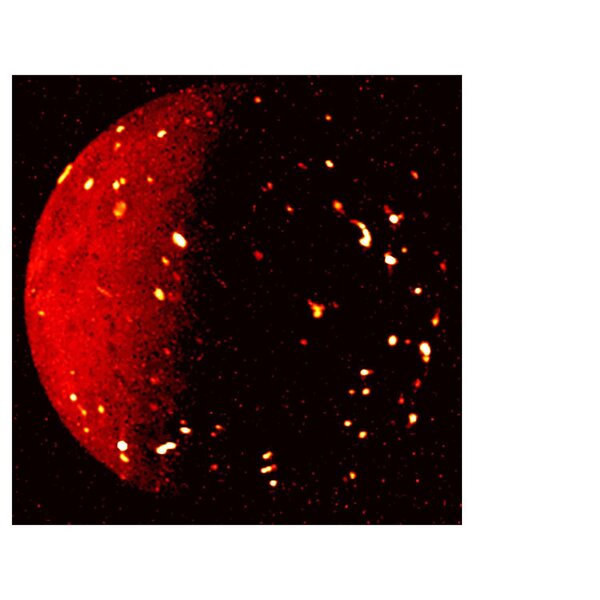Create a free profile to get unlimited access to exclusive videos, sweepstakes, and more!
'Dante's Peak' would look right at home on the surface of Jupiter’s volcano moon Io
Io is a great place to visit, but you wouldn't want to live there.

On Earth, finding yourself within shouting distance of an active volcano is a one-ingredient recipe for a very bad day. It doesn’t get much more serious than the ground beneath your feet bursting into flames, just ask the residents of the fictional town of Dante’s Peak, if you can find any survivors. In astronomy, however, volcanic activity presents an exciting scientific opportunity to investigate the ways planets and moons behave and evolve over time. And there’s nowhere more volcanic, at least nowhere nearby, than Jupiter’s fourth-largest moon, Io (pronounced eye-oh).
NASA’s Juno spacecraft began its mission the way all spacecrafts do, with a powerful but controlled explosion carrying it into space. After five years and almost two billion miles of travel through the vast emptiness of the cosmos, Juno arrived in the Jovian system on Independence Day, 2016. Its primary mission consisted of 35 orbits around the largest planet in our solar system, during which it collected terabits of data, including scores of gorgeous pictures of Jupiter and its moons.
RELATED: Juno digs into Jupiter and sees the Great Red Spot goes way deeper than thought
With its primary mission completed, Juno turned its attention toward Ganymede, Jupiter’s largest moon, with a mass roughly twice that of our own Moon. This marked Juno’s transition away from its focus on Jupiter and toward its next phase exploring the wider Jovian system. Later, Juno moved on from Ganymede to study Europa, the icy world which just might harbor alien life in the global ocean beneath its frozen ice shell.
Now Juno is moving on once again, and this time it’s focusing its robotic attention — not to mention its various instruments — on the scorched volcanic world of Io. NASA recently released an image of the fiery moon, originally taken by Juno in July of this year, which showcases the moon’s explosive splendor.
That image was captured in the infrared, using Juno’s Jovian Infrared Auroral Mapper (JIRAM), which is why it looks so unusual. In infrared, the intensity of color represents temperature, not brightness. The brighter the spot, the hotter the flames. A quick glance reveals that Io is the forever host of the galactic Floor Is Lava championships.
“You can see volcanic hotspots. We’ve been able to monitor over the course of the primary mission — over 30 orbits — how this changes and evolves,” said Scott Bolton, principal investigator for NASA’s Juno spacecraft, in a press event at the American Geophysical Union, via Insider.
RELATED: First wave of striking up-close Ganymede images arrive from NASA's Juno spacecraft
Io is the most volcanically active known location in the solar system, harboring hundreds of actively erupting volcanoes at any given time, according to NASA. It provides a window into what the early solar system may have been like, when the planets were young, full of fire and ire. Now, Io is the only holdout of a planetary lifestyle not seen in our solar system for billions of years. Understanding it is a path toward understanding ourselves, or at least the evolution of our own planet.
Io is Juno’s home base for the next year and a half. Just a few days ago, on December 15, Juno initiated the first of nine flybys, some of which will bring the orbiter closer than a thousand miles from the blazing surface of Io. During those passes, scientists will carry out the first high-resolution monitoring of the moon’s volcanic activity. They’ll also investigate any interactions between the volcanic activity and Jupiter’s magnetosphere and aurora. It’s believed that Io’s activities might create a special auroral footprint by accelerating charged particles in Jupiter’s atmosphere. Whatever they find, we’re sure to get some more incredible imagery from Juno in the coming months and years. Io… so hot right now.
If you just can’t wait for Juno’s next blistering update, join the fight against giant lava-breathing tarantulas in Lavalantula, now streaming on Peacock!



























